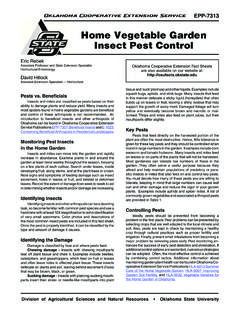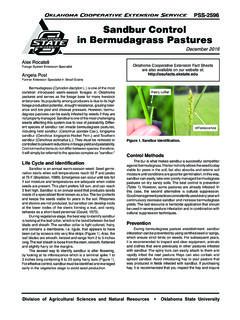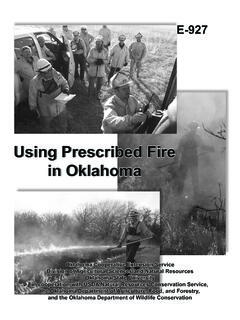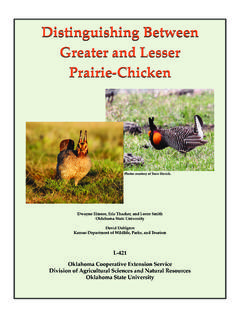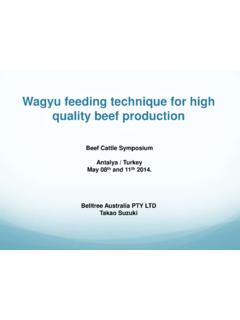Transcription of Nutrient Requirements of Beef Cattle - DocuShare
1 Nutrient Requirements of beef Cattle E-974. Department of Animal Science Oklahoma Cooperative Extension Service Division of Agricultural Sciences and Natural Resources Oklahoma State University 1. David Lalman DM Intake, % of Body Weight Professor, beef Cattle 3. Chris Richards 300 lbs Associate Professor, beef Cattle 2 600 lbs Objectives 1. Discuss the Nutrient Requirements of beef Cattle . Provide tables that list the Nutrient Requirements of 0. beef Cattle . 54 59 64 69 75 83. Explain how a balanced and cost effective nutrition TDN, % of Diet Dry Matter program is essential to the success of any beef Cattle operation. Figure . The relationship of diet digestibility to dry matter intake in growing calves. Source: NRC. Expensive grasslands demand efficient utilization of forages.
2 Supplemental feeding and complete feeding programs must be designed to meet the Nutrient needs of beef Cattle and at the DM Intake, % of Body Weight same time make the most of the available feed resources. Nutri- ent Requirements of Cattle change with age, stage of production, sex, breed, environmental conditions and basal diet quality and amount. Therefore, gaining knowledge of Nutrient Requirements and the factors influencing these Requirements is a necessary first step to designing a nutrition program that is both efficient and cost effective. This section will discuss the protein, energy, min- 2. eral and vitamin Requirements of beef Cattle . In addition, tables of Nutrient Requirements are provided. Dry Matter Intake 42 47 52 57 62 67. There really is no requirement for feed intake, although an TDN, % of Diet Dry Matter estimate of how much forage and feed an animal will consume Figure.
3 The relationship of forage digestibility to dry is essential when evaluating rations, supplements or predicting matter intake in beef cows. Source: NRC. animal performance. Dry matter (DM) intake is influenced by a number of different factors. A few of the more important variables DM Intake, % of Body Weight include animal weight, condition, stage of production, level of milk 3. production, forage quality, amount and type of supplement or feed provided, as well as environmental conditions. Cattle have a daily requirement for a certain quantity of specific nutrients such as protein, calcium and vitamin A. The necessary 2. concentration of these nutrients in the diet (to meet the animal's requirement) is then determined by the amount of feed consumed. For example, steer calves gaining 2 pounds per day may require 1.
4 Pounds of protein per day. If they consume 15 pounds of DM. daily, the protein requirement could be expressed as percent of DM intake. On the other hand, if they are limit fed to consume only 10 pounds of DM daily, the protein requirement for 2 pounds 0. of gain could be expressed as 16 percent of DM intake. Late Early Late Gestation Lactation Lactation Intake in forage-fed Cattle is generally limited by the forage capacity of the digestive tract. Values presented in Table 1 provide Figure Dry matter intake, expressed as percent of rule-of-thumb guidelines for variation in DM intake based on dif- body weight, of beef cows consuming low quality forage ferences in forage quality and stage of production for beef cows. during three different stages of production. Source: Johnson Forage digestibility values rarely exceed 70 percent to 74 percent et al.
5 Of DM. Calves and yearlings frequently are fed higher quantities of concentrate feeds to improve weight gain and feed conversion above what can be achieved with forage alone. When diet digest- Forage intake is highly correlated with forage quality as shown ibility approaches 70 percent, feed intake is no longer regulated in Figure 2 and in Table 1. The more rapid rate of digestion and or limited by the capacity of the digestive tract. Rather, with diets passage of higher quality forage results in considerably higher high in digestible energy, physiological mechanisms are turned dry matter intake compared to forage lower in digestibility. on to limit intake (Figure 1). This response can be thought of as Cattle with greater mature body weight and frame size con- a built-in safety mechanism so Cattle are less likely to consume sume more forage compared to smaller frame Cattle .
6 Lactating too much of a highly digestible diet, causing digestive upset, bloat cows consume considerably more of the same quality forage and founder. compared to gestating cows (Figure 3). Additionally, fleshy Cattle 2. Table 1 . Forage capacity of beef cowsa. Forage Type and Maturity Stage Forage Dry Matter Intake of Production Capacity, % of Body Weight Low quality forage (< 52% total digestible nutrients) Dry Dry winter forage, mature legume and grass hay, straw Lactating Average quality forage (52% to 59% total digestible nutrients). Dry summer pasture, dry pasture during fall, late-bloom Dry legume hay, boot stage and early-bloom grass hay Lactating High quality forage (> 59% total digestible nutrients). Mid-bloom, early-bloom, and prebloom legume hay, Dry preboot stage grass hay Lactating Lush, growing pasture Dry Lactating Silages Dry Lactating a Intake estimates assume protein Requirements are met by the forage or through supplementation when forage protein is not adequate.
7 When protein Requirements are not met, forage intake will be lower than the values shown in the table. Source: Hibbard and Thrift. consume 3 to 10 percent less feed or forage compared to Cattle The crude protein system has been the standard for evaluating that are in average to thin condition. Cold stress increases dry beef Cattle protein Requirements and dietary supply for a long time. matter intake, while heat stress reduces dry matter intake. With More recently, the metabolizable protein system has been this many factors influencing this trait, dry matter intake is very used to better characterize protein degradability as well as its difficult to accurately predict. site and extent of digestion. To effectively use this new system, Estimates of dry matter intake presented in the Nutrient the user must become familiar with several new terms.
8 These requirement tables are determined using published prediction include degradable intake protein (DIP), undegradable intake equations. These equations take into account the effects of the protein (UIP) and metabolizable protein (MP). Degradable intake animal's weight, level of milk production for lactating cows, en- protein is the feed protein fraction that is degraded in the rumen. ergy content of the diet, stage of production and body condition Nitrogen from DIP is used either for microorganism protein syn- in the case of the pregnant replacement heifers. It is important to thesis or passes through the rumen wall into the blood stream note all of these equations assume adequate protein is supplied and is carried to the liver as ammonia. In the liver, this nitrogen in the diet to maximize ruminal fermentation.
9 In other words, can be converted to urea, after which it is recycled to the rumen if the diet is deficient in protein, these dry matter intake values through saliva or filtered out of the blood stream in the kidney will overestimate the amount the Cattle will actually consume. to be excreted in the urine. Undegradable intake protein is the feed protein fraction that bypasses fermentation in the rumen to Protein be degraded and absorbed in the small intestine. Metabolizable protein is the sum of protein derived from microorganism origin plus UIP (Figure 4). Proteins are large chemical units made up of hundreds of Perhaps one of the most practical applications of the MP. amino acids. Amino acids, in turn, are organic or carbon-containing system is the calculation of the animal's DIP requirement to compounds that also contain nitrogen, oxygen and sometimes ensure optimal rumen function.
10 For this reason, feed DIP values sulfur. Animals consume proteins in their diets, then utilize the are included in Table 1. The requirement for DIP is thought to amino acids for synthesis of muscles, blood proteins and other be closely associated with the amount of fermentable energy in body components. In swine, poultry and other nonruminants, the the diet. Specifically, the DIP requirement can be calculated as amino acids must be supplied in definite proportions in the diet. However, in ruminants, microorganisms (bacteria and protozoa). Feed Rumen break down most dietary proteins and incorporate the nitrogen and amino acids into their own body tissue. The microorganisms MP. are digested in the small intestine of the ruminant animal. The bacteria themselves have a protein requirement and must have CP.





